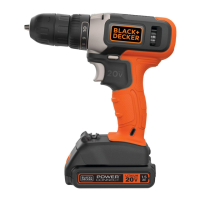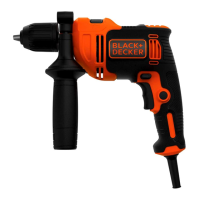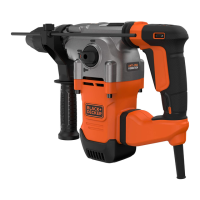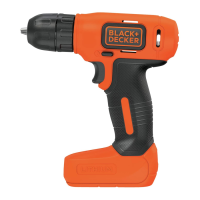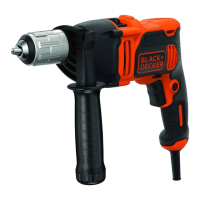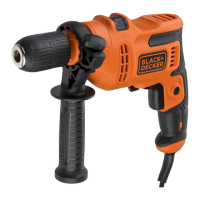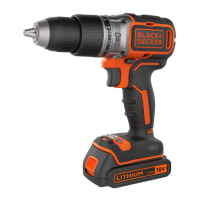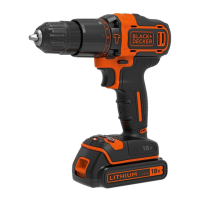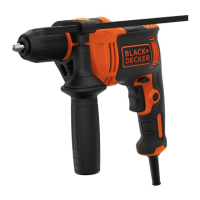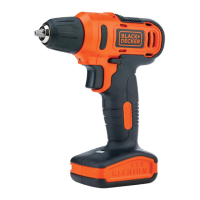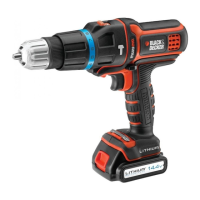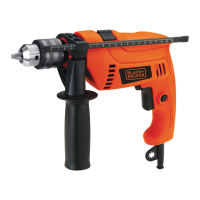For drilling in wood, metal and plastics, set the collar to
the drilling position symbol
For screwdriving, set the collar to the desired setting. If you
do not yet know the appropriate setting, proceed as
follows:
Set the collar to the lowest torque setting.
Tighten the rst screw.
If the clutch ratchets before the desired result is achieved,
increase the collar setting and continue tightening the
screw. Repeat until you reach the correct setting. Use this
setting for the remaining screws.
Keyless chuck (g. F)
@
Warning! Make certain the lock-off button (2) is
engaged to prevent switch actuation before installing
or removing accessories.
To insert a drill bit or other accessory:
Grasp the rear half of the chuck (4) with one hand
and use your other hand to rotate the front half in the
counterclockwise direction, as viewed from the chuck end.
Insert the bit or other accessory fully into the chuck, and
tighten securely by holding the rear half of the chuck and
rotating the front portion in the clockwise direction as
viewed from the chuck end.
@
Warning! Do not attempt to tighten drill bits (or
any other accessory) by gripping the front part of
the chuck and turning the tool on. Damage to the
chuck and personal injury may occur when changing
accessories.
Dual range gearing (g. G)
The dual range feature of your drill allows you to shift gears
for greater versatility. To select low speed, high torque setting
(position 1), turn tool off and permit to stop. Slide gear shifter
button (5) away from the chuck. To select the high speed, low
torque setting (position 2), turn tool off and permit to stop.
Slide gear shifter button towards the chuck.
Note: Do not change gears when tool is running. If you are
having trouble changing gears, make sure that the dual range
gear button is either completely pushed forward or completely
pushed back.
Drilling/screwdriving
Select forward or reverse rotation using the forward/
reverse slider (2).
To switch the tool on, press the switch (1). The tool speed
depends on how far you press the switch.
To switch the tool off, release the switch.
Hints for optimum use
Drilling
Use sharp drill bits only.
Support and secure work properly, as instructed in the
Safety Instructions.
Use appropriate and required safety equipment, as
instructed in the Safety Instructions.
Secure and maintain work area, as instructed in the
Safety Instructions.
Run the drill very slowly, using light pressure, until
the hole is started enough to keep the drill bit from slipping
out of it.
Apply pressure in a straight line with the bit. Use enough
pressure to keep the bit biting but not so much as to stall
the motor or deect the bit.
Hold the drill rmly with two hands to control its twisting
action.
DO NOT CLICK THE TRIGGER OF A STALLED DRILL
OFF AND ON IN AN ATTEMPT TO START IT. DAMAGE
TO THE DRILL CAN RESULT.
Minimize stalling on breakthrough by reducing pressure
and slowly drilling through the last part of the hole.
Keep the motor running while pulling the bit out of a drilled
hole. This will help reduce jamming.
Make sure switch turns drill on and off.
Drilling in wood
Holes in wood can be made with the same twist drill bits used
for metal or with spade bits. These bits should be sharp and
should be pulled out frequently when drilling to clear chips
from the utes.
Drilling in metal
Use a cutting lubricant when drilling metals. The exceptions
are cast iron and brass which should be drilled dry. The cutting
lubricants that work best are sulfurized cutting oil or lard oil.
Drilling in masonry
For drilling in masonry, set the collar (3) to the hammer
drilling position by aligning the symbol with the marking.
Slide the speed selector (5) towards the front of the tool
(2nd gear).
Screwdriving
Always use the correct type and size of screwdriver bit.
If screws are difcult to tighten, try applying a small
amount of washing liquid or soap as a lubricant.
Always hold the tool and screwdriver bit in a straight line
with the screw
Troubleshooting
Problem Possible cause Possible solution
Unit will not
start.
Battery pack not charged. Check battery pack
charging requirements
Battery pack
will not charge.
Charger not plugged
in.
Surrounding air temperature
too hot or too cold.
Plug charger into a working
outlet.
Move charger and battery
pack to a surrounding air
temperature of above 40
degrees F (45ºC) or below
105 degrees F (+40.5ºC)
8
ENGLISH
(Original instructions)
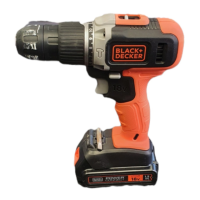
